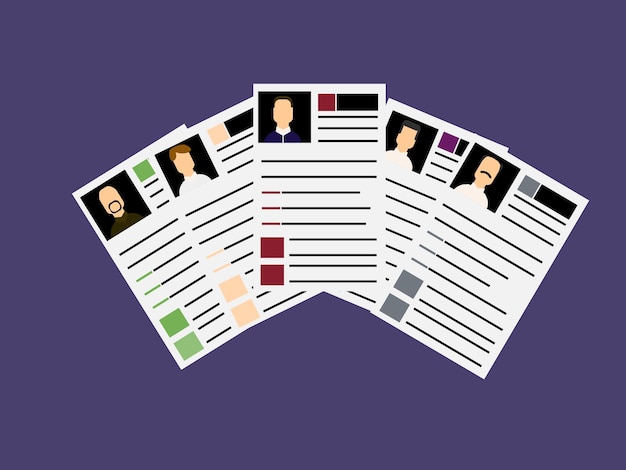Unmasking Bias: Hiring Practices in the US

Implicit bias can significantly impact hiring practices across the US, often leading to unfair and discriminatory outcomes that undermine diversity and meritocracy in the workplace. Understanding its psychological roots is crucial for fostering equitable opportunities and building truly inclusive environments.
In today’s interconnected world, the quest for truly equitable workplaces remains a significant challenge, especially when confronting the unseen forces of bias. The Psychology of Prejudice: Examining Implicit Bias in Hiring Practices Across the US delves into the subtle yet profound ways our unconscious minds can influence critical employment decisions, shaping who gets hired and who is overlooked. This exploration is not merely academic; it unpacks the real-world implications of ingrained societal patterns on professional lives and organizational diversity.
Understanding Implicit Bias: A Foundation
Implicit bias refers to the attitudes or stereotypes that affect our understanding, actions, and decisions in an unconscious manner. These biases are activated involuntarily and without an individual’s awareness or intentional control. They are largely shaped by experiences and associations made throughout one’s life, rather than explicit beliefs or prejudices.
The concept gained prominence with research establishing the Implicit Association Test (IAT), which measures the strength of associations between concepts and evaluations or stereotypes. Such tests have highlighted how pervasive these biases are, even among individuals who consciously reject prejudiced views. They operate beneath the surface, influencing snap judgments and filtering perceptions, which can have profound effects in high-stakes environments like hiring.
The Difference Between Implicit and Explicit Bias
It is crucial to distinguish between implicit and explicit bias. Explicit bias involves conscious attitudes and beliefs that an individual holds about a group, often openly expressed. For example, a person might consciously believe that a particular ethnic group is less intelligent. Implicit bias, conversely, functions outside of conscious awareness.
- Explicit Bias: Deliberate, conscious attitudes, often expressed openly.
- Implicit Bias: Unconscious attitudes and stereotypes, involuntarily activated.
- Impact: Explicit biases are easier to identify and address; implicit biases require different strategies due to their hidden nature.
Acknowledging this distinction is the first step in addressing the more subtle forms of discrimination that persist. While overt discrimination is legally and socially condemned, implicit biases can lead to equally harmful outcomes, often without anyone realizing that bias was a factor.
The challenge lies in the fact that implicit biases are often inconsistent with our stated beliefs. A hiring manager may genuinely believe in equal opportunity, yet subconsciously favor candidates who fit a certain demographic profile. This internal conflict makes it difficult to self-correct without external tools or intentional, structured interventions. The next section explores how these unconscious inclinations manifest specifically within the recruitment landscape across the United States.
The research on implicit bias continually evolves, providing deeper insights into its origins and manifestation. Studies show that mere exposure to certain cultural narratives or media portrayals can contribute to the formation of these biases, even in the absence of personal negative experiences. This highlights the systemic nature of the problem, where societal messaging plays a significant role in shaping individual unconscious thought patterns. Understanding these foundational aspects is essential for developing effective strategies to mitigate their impact.
Manifestations in Hiring Practices Across the US
Implicit biases infiltrate every stage of the hiring process, from the initial resume screening to the final interview. Their subtle presence makes them particularly insidious, as they can lead to decisions that appear fair on the surface but are inherently discriminatory at a deeper level. The nuances of these biases vary, reflecting the complex tapestry of American society.
During resume reviews, for instance, studies have shown that identical resumes are rated differently based on names that suggest a particular gender or ethnicity. A “Jamal” or “Lakisha” may receive fewer callbacks than “Brendan” or “Emily,” even with identical qualifications. This phenomenon, often termed “resume whitening,” illustrates how unconscious biases can prematurely filter out qualified candidates based on non-meritocratic criteria.

The Interview Stage: A Hotbed for Bias
The interview is perhaps the most vulnerable stage for implicit bias. Face-to-face interactions introduce a host of non-verbal cues and subjective judgments that can be swayed by unconscious associations. Interviewers might subconsciously favor candidates who share similar backgrounds, schools, or hobbies, interpreting “cultural fit” in ways that exclude diverse talent.
- Affinity Bias: Favoring individuals who are similar to oneself.
- Confirmation Bias: Seeking or interpreting information in a way that confirms one’s preconceptions.
- Halo/Horn Effect: Extending a positive or negative impression of one trait to the entire person.
These biases can manifest in unequal questioning, where interviewers probe minority candidates more critically or provide less support and encouragement than they do to majority candidates. The subjective nature of interview assessments makes it challenging to pinpoint exactly where bias occurred, further complicating efforts to address it.
Beyond individual biases, organizational culture can also exacerbate these issues. Companies that lack clear, standardized interview protocols or rely heavily on ‘gut feelings’ are more susceptible to implicit bias. When hiring decisions are made behind closed doors with little transparency, the effects of unconscious prejudices can amplify, perpetuating homogeneous workforces.
The impact extends to salary negotiations and initial job offers, where implicit biases can lead to lower starting salaries or fewer benefits for women and minority groups, creating a ripple effect on their long-term earning potential and career progression. Acknowledging these pervasive manifestations is critical for developing robust, evidence-based interventions.
The Psychological Roots of Prejudice
Prejudice, in its broadest sense, is a preconceived opinion that is not based on reason or actual experience. Its psychological origins are multifaceted, extending beyond overt hatred to deeply ingrained cognitive shortcuts and social conditioning. Understanding these roots is crucial to tackling implicit bias effectively.
One primary psychological root is categorization. Our brains are wired to categorize information to simplify the complex world around us. This cognitive efficiency, while useful for survival, can lead to overgeneralizations about groups of people. Once individuals are categorized, stereotypes—oversimplified mental images of groups—can easily attach, creating a ready framework for biased judgments.
Cognitive Biases and Social Conditioning
Beyond basic categorization, several cognitive biases contribute to the perpetuation of prejudice. The “in-group/out-group” phenomenon, for example, describes our natural tendency to favor members of our own group over others. This tribal inclination can lead to a devaluation of those outside our immediate social circles, often without conscious malice.
Social learning also plays a significant role. From a young age, individuals absorb cultural messages, media portrayals, and the attitudes of their peers and elders. These inputs, whether explicit or implicit, shape our associations and can embed prejudiced ideas into our unconscious minds. Even if we consciously reject these messages, the implicit associations can persist.
- Availability Heuristic: Overestimating the likelihood of events that are more easily recalled from memory (e.g., highly publicized crimes attributed to a specific group).
- Fundamental Attribution Error: Attributing others’ behaviors to their character or disposition, while attributing our own to situational factors.
- Groupthink: The tendency for cohesive groups to prioritize harmony and conformity, leading to biased decision-making.
The threat of stereotype—the risk of conforming to a negative stereotype about one’s group—can also impact individuals during evaluations, such as interviews. This anxiety can impair performance, inadvertently confirming existing prejudicial beliefs and creating a vicious cycle.
Understanding these deep-seated psychological mechanisms is vital because they highlight that implicit bias is not simply a matter of individual “bad actors.” Instead, it is a complex interplay of cognitive processes, social conditioning, and systemic structures that reinforce unequal outcomes. Addressing prejudice effectively requires interventions that target these underlying roots, rather than just superficial manifestations.
The Impact of Implicit Bias on Diversity and Inclusion
The subtle machinations of implicit bias have far-reaching consequences, particularly for organizational diversity and inclusion initiatives. When hiring processes are tainted by unconscious preferences, the resulting workforce tends to be less diverse, perpetuating homogeneity that can stifle innovation and limit market insights. This homogenous environment then reinforces existing biases, creating a cycle that is difficult to break.
A lack of diversity in leadership and across an organization can lead to a narrow range of perspectives and experiences, hindering problem-solving and strategic planning. Companies with diverse teams are often better equipped to understand and serve a broader customer base, adapt to changing markets, and foster a more vibrant, dynamic workplace culture. Implicit bias acts as a barrier to achieving these benefits.
Consequences for Individuals and Organizations
For individuals, being subjected to implicit bias can mean missed opportunities, slower career progression, and a sense of unfairness. This can lead to decreased morale, higher turnover rates, and a diminished sense of belonging, especially for those from underrepresented groups. The cumulative effect of these micro-aggressions and missed chances can be debilitating over a career.
For organizations, the failure to address implicit bias results in a narrower talent pool, limiting access to top performers. It can also lead to legal and reputational risks, as companies are increasingly scrutinized for their diversity practices. Beyond legal compliance, strong diversity and inclusion metrics are now considered indicators of a forward-thinking and ethical organization, impacting public perception and consumer loyalty.
- Reduced Innovation: Homogeneous teams tend to be less innovative.
- Limited Market Reach: Lack of diverse insights can alienate customer segments.
- Lower Employee Morale: Perceived unfairness impacts retention and engagement.
- Reputational Damage: Public and media scrutiny can harm brand image.
The financial implications are also significant. Studies indicate that companies with diverse workforces outperform their less diverse counterparts in terms of profitability and shareholder value. Implicit bias undermines these potential gains by preventing companies from building the diverse teams that drive superior performance.
Ultimately, addressing implicit bias is not just about fairness; it is a strategic imperative for organizations aiming to thrive in an increasingly diverse and competitive global landscape. It necessitates a proactive and systematic approach to break down the unconscious barriers that impede true meritocracy and inclusion.
Strategies for Mitigation and Prevention
Mitigating implicit bias in hiring practices requires a multifaceted and sustained effort, focusing on both individual awareness and organizational systemic changes. It’s not about eradicating bias entirely—which may be impossible—but about neutralizing its impact on decision-making. A strategic approach combines training, process reengineering, and cultural shifts.
Firstly, awareness training is crucial. While a single training session may not eliminate biases, it can make individuals aware of their existence and potential impact. This awareness is the first step toward self-correction. Training should focus on helping individuals recognize their blind spots and provide practical tools for interrupting biased thought processes.
Practical Interventions and Systemic Changes
Beyond awareness, concrete changes to hiring processes are essential. Blind resume reviews, where identifying information (names, addresses, universities) is removed, can significantly reduce initial screening bias. Standardized interview questions, scored against predefined criteria, help ensure that candidates are evaluated consistently and objectively.
- Structured Interviews: Use a consistent set of questions and evaluation criteria for all candidates.
- Diverse Interview Panels: Include interviewers from diverse backgrounds to introduce multiple perspectives.
- Objective Criteria: Define clear, observable, and job-related criteria for assessment.
- Data-Driven Decisions: Analyze hiring data to identify patterns of bias and track progress.
Another powerful strategy is requiring justification for hiring decisions. When interviewers must articulate the specific, objective reasons for choosing one candidate over another, it forces them to move beyond ‘gut feelings’ and confront potential biases. This transparency increases accountability and promotes more reasoned decision-making.
Mentorship and sponsorship programs can also help mitigate implicit bias by exposing decision-makers to diverse talent they might otherwise overlook. These programs build relationships and challenge preconceived notions, fostering a more inclusive organizational culture where diverse perspectives are valued and promoted.
Finally, fostering a culture of psychological safety where employees feel comfortable discussing bias and discrimination without fear of retaliation is paramount. This allows for open dialogue, learning, and continuous improvement, ensuring that anti-bias efforts are not one-off initiatives but integral to the organization’s continuous journey towards equity. By implementing these strategies, organizations can move closer to creating truly meritocratic and inclusive hiring environments, benefiting from the full spectrum of diverse human talent.
Legal and Ethical Implications in the US
The presence of implicit bias in hiring practices carries significant legal and ethical implications within the United States. While intent to discriminate might be absent, the disparate impact of biased decisions can still lead to legal challenges. US employment law, particularly Title VII of the Civil Rights Act of 1964, prohibits discrimination based on race, color, religion, sex, and national origin, covering both intentional discrimination and practices that have a discriminatory effect.
Even if an employer genuinely believes their hiring process is fair, statistical evidence showing that certain groups are disproportionately excluded can lead to “disparate impact” claims. In such cases, the employer must demonstrate that the discriminatory practice is a business necessity and that no less discriminatory alternative exists. Implicit biases, by their very nature, can create such disparate impacts, making companies vulnerable to lawsuits and regulatory actions.
Beyond Compliance: The Ethical Imperative
Beyond legal compliance, there is a strong ethical imperative to address implicit bias. Fundamental principles of fairness, equality, and justice dictate that individuals should be evaluated based on their merits and qualifications, not on unconscious prejudices related to their identity. Organizations have a moral responsibility to create environments where all individuals have an equal opportunity to thrive.
Failing to address implicit bias can erode trust among employees and the wider community. It signals a lack of commitment to diversity and inclusion, potentially damaging an organization’s reputation and its ability to attract and retain top talent. Ethical leadership requires proactive steps to identify and dismantle barriers to equity, regardless of legal mandates.
- Legal Consequences: Disparate impact lawsuits, financial penalties, court-ordered remedies.
- Ethical Responsibility: Upholding principles of fairness, equality, and justice.
- Reputational Harm: Negative public perception, difficulty attracting talent.
The ethical dimension also extends to the well-being of individuals affected by bias. The psychological toll of experiencing repeated discrimination, even if subtle and unintentional, can be profound. It can lead to feelings of frustration, resentment, and a sense of being undervalued, impacting mental health and overall job satisfaction.
Therefore, addressing implicit bias is not merely a box to check for legal or PR purposes. It is a fundamental commitment to building a more just and equitable society, starting with the foundational aspect of employment. This requires constant vigilance, continuous learning, and a willingness to challenge deeply entrenched norms to ensure that opportunities are truly open to all.
The Future of Fair Hiring
The evolving landscape of fair hiring in the US suggests a future where technology, data, and a deeper understanding of human psychology will play critical roles in combating implicit bias. As awareness of implicit bias grows, so too does the demand for innovative solutions that can create truly equitable recruitment processes. This isn’t just about avoiding legal pitfalls; it’s about optimizing talent acquisition for a competitive global economy.
Artificial intelligence (AI) and machine learning (ML) are emerging as powerful tools in this quest. While AI itself can carry biases if fed with biased data, its potential lies in structured, objective assessment. Algorithms can be trained to screen resumes and even evaluate interview responses based purely on predefined competencies, stripping away demographic identifiers that might trigger human bias. However, vigilance is needed to ensure these AI systems are developed and deployed ethically, with regular audits for algorithmic fairness.
Technology and Continuous Improvement
The future also envisions increased use of blind screening technologies, not just for resumes but for skills assessments and initial candidate interactions. Virtual reality (VR) and augmented reality (AR) could offer immersive, standardized interview environments that minimize subjective human interaction until later stages, allowing for more objective initial evaluations.
Furthermore, the continuous analysis of diversity metrics and hiring funnels will become standard practice. Organizations will leverage big data to identify where biases are creeping into the process and to measure the effectiveness of their mitigation strategies. This data-driven approach will replace guesswork with evidence-based interventions.
- Algorithmic Fairness: Developing AI tools designed to prevent bias in hiring.
- Skills-Based Assessments: Prioritizing demonstrable skills over credentials susceptible to bias.
- Diversity Analytics: Using data to track and improve hiring equity.
- Inclusive Culture Building: Fostering environments where all employees can thrive.
Ultimately, the future of fair hiring will depend on a holistic approach that integrates technological advancements with a strong commitment to ethical principles and ongoing education. It will involve creating a culture where inclusion is not just a policy but a core value, consistently reinforced through every hiring decision and organizational practice. The journey toward completely bias-free hiring is long, but the tools and understanding are steadily advancing, paving the way for more equitable workplaces across the United States.
Embracing these advancements, while remaining critically aware of their limitations and potential for new forms of bias, is key. The goal remains the same: ensuring that every candidate is evaluated on their unique merits, contributing to a more diverse, innovative, and resilient workforce for the challenges of tomorrow.
| Key Aspect | Brief Description |
|---|---|
| 🤔 Implicit Bias Defined | Unconscious attitudes and stereotypes that affect decisions without awareness. |
| 📝 Hiring Impact | Influences resume screening, interviews, and job offers, leading to less diverse hires. |
| 🛠️ Mitigation Strategies | Awareness training, structured interviews, blind screening, and data analysis. |
| ⚖️ Legal & Ethical Side | Risk of disparate impact lawsuits and moral imperative for fair treatment. |
Frequently Asked Questions About Implicit Bias in Hiring
Implicit bias in hiring refers to unconscious attitudes or stereotypes that affect how employers perceive and evaluate job candidates. These biases operate involuntarily and without conscious awareness, leading to potentially unfair advantages or disadvantages for certain individuals based on factors like gender, ethnicity, or age, rather than qualifications.
Implicit bias can appear at various stages: in resume screening (e.g., favoring certain names), during interviews (e.g., asking different questions or forming quicker judgments based on non-verbal cues), and in final decisions (e.g., preferring candidates who share similar backgrounds). It often influences perceptions of “cultural fit” in subtle, unacknowledged ways.
Completely eliminating implicit bias is challenging, as it stems from deeply ingrained cognitive processes and societal conditioning. However, its impact can be significantly mitigated through awareness, structured hiring processes, and ongoing training. The goal is to reduce its influence on decision-making rather than achieving complete eradication of all unconscious associations.
Effective strategies include implementing blind resume reviews, standardizing interview questions and evaluation criteria, forming diverse interview panels, providing bias awareness training, and utilizing data analytics to track and identify potential biases in the hiring pipeline. Focusing on skills-based assessments rather than subjective traits also helps.
Addressing implicit bias is crucial for organizations to foster diversity, enhance innovation, improve employee morale, and reduce legal risks. Diverse teams often lead to better problem-solving and financial performance. Ethically, it ensures fair and equitable opportunities, building a more just and inclusive workplace culture that aligns with societal values.
Conclusion

The journey to truly fair and equitable hiring practices in the United States is complex, rooted deeply in the unseen currents of human psychology. As we’ve explored, implicit bias is not merely a theoretical concept but a pervasive force that shapes who gets opportunities, influencing everything from initial resume screenings to final job offers. Its impact extends beyond individual careers, significantly affecting organizational diversity, innovation, and ultimately, societal progress. Acknowledging its existence and understanding its psychological underpinnings is the crucial first step. Moving forward, a combination of heightened individual awareness, strategically reengineered hiring processes, and the ethical application of technology offers the most promising path. While the complete eradication of bias may remain an aspirational goal, continuous efforts to mitigate its effects are paramount. Organizations, leaders, and individuals alike share a collective responsibility to challenge these unconscious inclinations, fostering workplaces where merit truly reigns supreme and diverse talent is recognized and cultivated without prejudice. The future of equitable employment hinges on this sustained commitment to fairness and conscious inclusion.





